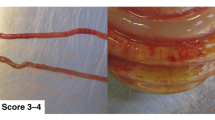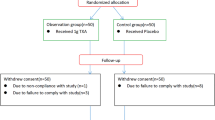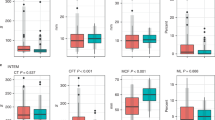Abstract
ABSTRACT. To explore the pathophysiology of the necrotizing enterocolitis caused by polycythemia in the newborn dog, the effect of acute polycythemia on fibrinogen disappearance rate was studied in 38 puppies (3-14 days). All pups received an exchange transfusion removing 65 ml/ kg of blood and transfusing 85 ml/kg of either whole blood (control, resulting hematocrit=37), or packed red blood cells (polycythemia, resulting hematocrit=68). Necrotizing enterocolitis was found in 15 of 19 polycythemic and four of 19 control pups (p<0.01). 125I fibrinogen and Evan's blue (an albumin marker) were injected 2 h after transfusion and the concentration of clottable labeled fibrinogen and albumin tracer were measured at Vi and 2 h after injection. The fraction of the tracer that disappeared over the 1 Vi-h period was calculated. In the polycythemic group 45 ± 18 SD% of the clottable fibrinogen disappeared versus only 28 ± 15% in the control group (p<0.01). In the polycythemic group 36 ± 21% of the albumin tracer disappeared versus 31 ± 12% in the control group (NS). Thus polycythemia in the newborn dog is associated with an increased disappearance rate of clottable fibrinogen not associated with a general increase in protein disappearance rate. Thus an intravascular coagulopathy is evident in the polycythemic animals. Whether this coagulopathy is the cause of the necrotizing enterocolitis or is secondary to the necrotizing enterocolitis seen in this animal model cannot be determined from this experiment.
Similar content being viewed by others
Log in or create a free account to read this content
Gain free access to this article, as well as selected content from this journal and more on nature.com
or
Author information
Authors and Affiliations
Rights and permissions
About this article
Cite this article
Leblanc, M., Edwards, J. Acute Polycythemia Increases the Disappearance Rate of Clottable Fibrinogen in the Newborn Dog. Pediatr Res 20, 151–154 (1986). https://doi.org/10.1203/00006450-198602000-00011
Received:
Accepted:
Issue date:
DOI: https://doi.org/10.1203/00006450-198602000-00011



